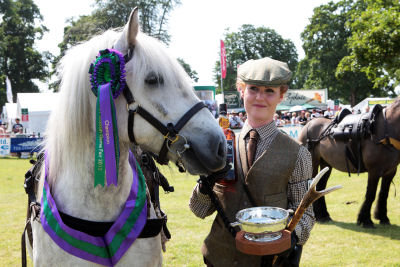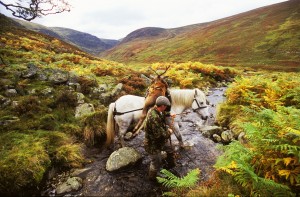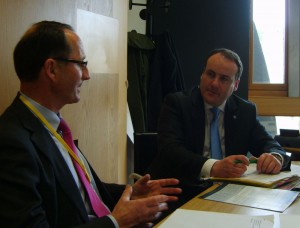The RACCE Committee of the Scottish Parliament met this week for its second session gathering evidence on deer management and the environment. The panel consisted of Robbie Kernahan (SNH), Simon Hodge (Forest Enterprise Scotland) Will Boyd Wallis (Cairngorms National Park Authority) and Professor John Milne (former chairman of DCS).
As in the previous session the range of questions was broad – deer numbers; the impact of deer on designated sites and features as well as the impact of other herbivores; whether a licensing scheme for DMGs would work; the effectiveness of existing legislation and the Code; inclusiveness and transparency of DMGs and, ultimately, whether the current voluntary deer management system is working.
Numbers of deer inevitably received some attention although both Robbie Kernahan and John were keen to stress that impacts were of far greater importance. Robbie Kernahan said that his calculation of the deer population needed to achieve the present level of sporting cull of around 15,000 stags per annum was 112,000 stags, 112,000 hinds and around 33,000 calves – 257,000 total. His written evidence includes a table of the most recent SNH aerial deer counts showing a total of 275,000.
Nigel Don MSP wanted to know more about discrete deer populations, how far they would migrate and whether a map existed to show where these populations were. It was explained that, broadly speaking, DMGs had been set up to reflect discrete local populations and that the overall range is best illustrated by the ADMG map
John Milne cited Caenlochan as a situation where a sub-population was being managed, and that effective management locally was more important than attempting to manage red deer across Scotland as a whole.
Simon Hodge said that the some 9 per cent of Scotland was managed under the National Forest Estate, and this accounted for around one third of Scotland’s total deer cull.
Robbie Kernahan said that a key role of SNH, and for ADMG, was to help deer groups come to terms with how they could reconcile different and often conflicting objectives. The role of DMGs was changing from where their primary task had been jointly to agree and execute their cull to meeting a range of objectives in both their own and the public interest including carbon sequestration and climate change as well as environmental and conservation targets. He said that DMGs should provide a framework for mature discussion, compromise and consensus with all members having a shared responsibility.
There was concern that the environmental voice alongside others representing the public interest was not getting a welcome or a fair hearing at DMGs, to which Robbie Kernahan said that “a significant cultural shift” had taken place and that there were many examples of good DMGs.
Will Boyd Wallis said that he too had seen dramatic change over the last 20 years, and there was now a far greater “spirit of trust, understanding and cooperation” and that ADMG’s recently published guiding principles had been a very positive step forward.
Simon Hodge echoed this, but suggested it might be helpful to have broader representation at DMG meetings, including farming and crofting interests. Will Boyd Wallis suggested that DMGs might consider an AGM that members of the wider public could attend. Robbie Kernahan said that ADMG was providing the lead nationally, and what was required was the capacity within DMGs in turn to become more effective.
There was some discussion over whether enough DMGs had deer management plans and whether those that did actually used them. Angus Macdonald MSP suggested a licensing system to censure those that did not do so, although it was questioned how such a system could work in practice.
Rob Gibson MSP, the Committee Chairman, revisited his correspondence with Corrour where a figure of 55 deer per sq km had been cited. Robbie Kernahan however called this a “snapshot in time” and that there was a danger in reading too much into a single figure as this would by no means represent an average over the ground which is very much less in that area.
Jim Hume MSP wanted to know about how the impact of deer on designated sites and features was assessed and evaluated. Robbie Kernahan said that in a Scottish context over 80 per cent of features were in stable or improving condition although some concerns remained for certain areas of woodland and peatland SACs. However it would be unreasonable to expect a 100 per cent record. The Scottish Government target is 95 per cent. There had been progress over the last three years. LINK had said that to have a deer management plan would constitute enough to change the status of a site to ‘recovering’, However Robbie Kernahan said that whilst a plan was important, the vital element was that management prescriptions as outlined in the plan were being deployed.
In response to a question from Angus Macdonald MSP, Robbie Kernahan said that SNH resources had to be channeled into areas at most risk such as designated sites or in the public interest (such as RTAs). Priorities were resource driven, and that not all issues were in relation to red deer (for example 350 roe deer had been shot in one year on Mar Lodge).
Simon Hodge said that roe accounted for 40 per cent of the FE cull, red deer 40 per cent, and other species the balance. John Milne said that roe were an increasing issue with the planting of new woodlands particularly through the Central Belt. Cara Hilton MSP raised the question of effective deer management over low ground areas.
Alex Fergusson MSP wanted to know how effective the Code had been over its 18 months lifespan. Robbie Kernahan said that the Code placed a responsibility on all landowners although it had been dismissed in the previous evidence session as a “red herring”. Whilst it was not legally binding it did represent the first time such responsibilities had been placed on land managers.
As most DMGs only meet twice a year then the Code was still new to many but that ”the penny has dropped”. John Milne however thought the Code was “anodyne” and “not very helpful”.
A number of MSPs wanted to know why there had been no deer panels or Section 7s or 8s implemented since the Act. Robbie Kernahan gave an update, advising that only one, Mar Lodge, had been implemented since the Act, but that two new Section 7s were imminent.
He said however that Section 7s and 8s were “resource hungry” both in terms of staff time and financial cost, and the fact that there were very few implemented could be seen as a reflection that they were there as a last resort. The Caenlochan Section 7 had shown just how effective the system could be. John Milne pointed out that a Section 7 could only be deployed where there was a designated site.
Claire Baker MSP wanted to know if the current deer management system was robust enough given the wider issues of climate change and land reform.
Simon Hodge said that it was beneficial to have greater clarity of expectation on land managers, that the Code needed to be “unpacked” and that it could be used to create a more collaborative environment. ADMG’s 6 principles were vital to moving forward and achieving consensus.
It was agreed that more inclusiveness was important, and that ADMG has a key role in bringing its members up to speed. Robbie Kernahan said it would be helpful if SNH could provide more support, but that DMGs had never before been asked to be proactive about sharing what they do, publishing plans or having websites, and that there was not always the capacity within DMGs to do this. Funding for DMGs was discussed and it was advised that uptake of previous funding streams through the SRDP, because Groups could not apply, had been poor (totaling just £190,000 across 14 applications).
Rob Gibson MSP said that conversely estates should possibly be paying sporting rates for the benefit of having deer on their ground and the ability to ‘take’ them.
John Milne said that in his view the solution lay in changing the status of deer, and this would require a change in the law. Rob Gibson asked if there were other countries with a model that could be followed in Scotland. Robbie Kernahan said this had been addressed by an SNH study in 2010 and, not surprisingly, the Scottish system was unique.
Overall it was a fair debate. The majority of the panel remained in favour of the current system but that it could be improved, particularly if SNH was better resourced. The Committee gave little away although, despite the strength of evidence presented over the two sessions, they do I suspect remain highly sceptical that ‘voluntary’ can deliver, let alone that ‘voluntary’ is best. It is difficult to gauge where this goes next, but certainly the effectiveness of DMGs, the current system, and the uptake of the Code will be in the spotlight for some time to come.




